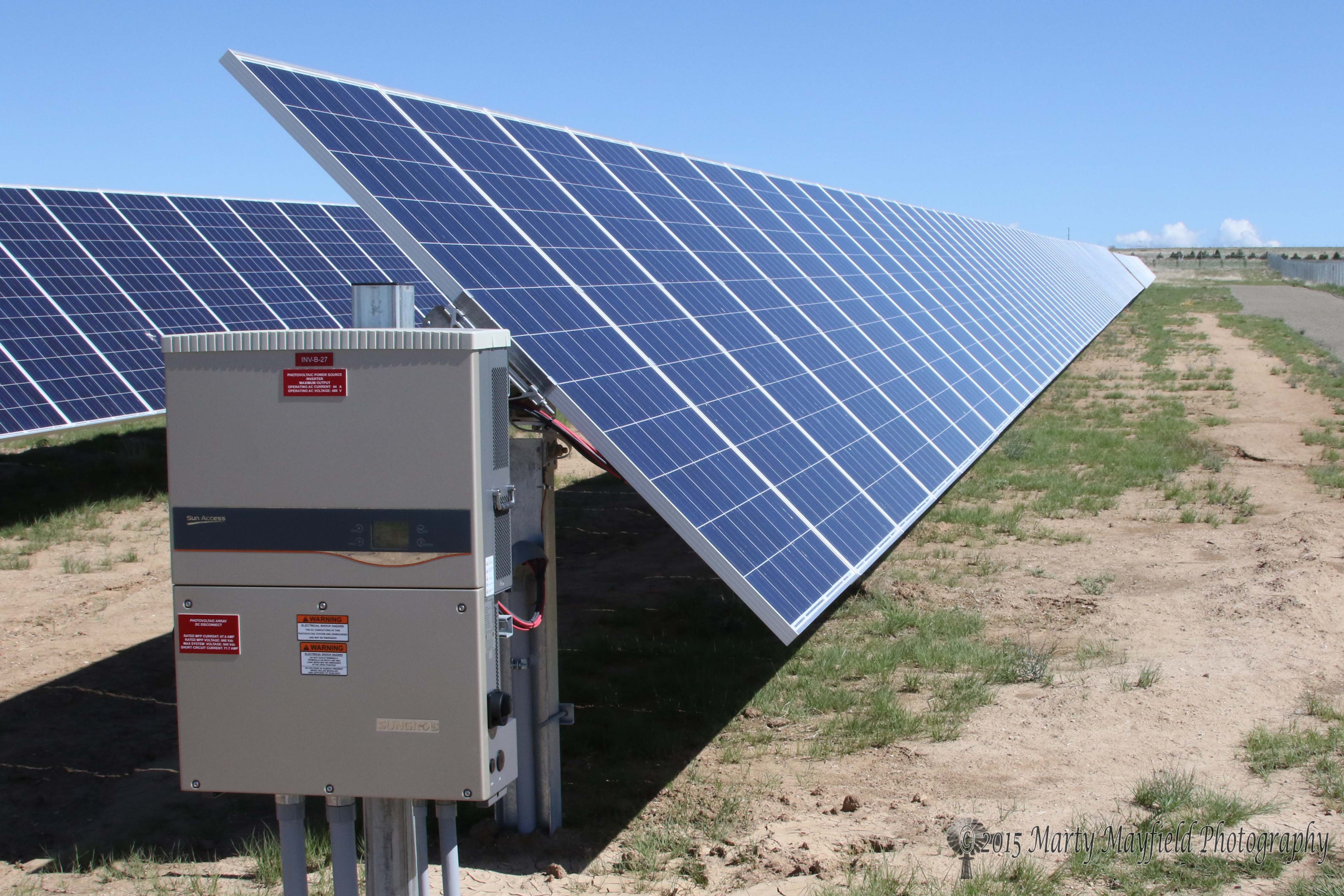By Marty Mayfield
KRTN Multi-Media
On Wednesday evening, February 27, the Raton Public Service Board heard from John Budd with Awaken 1605 and Steve Herrera of Inner-Sol about a solar project they are working on near Aguilar and how it could possibly help Raton move in the direction of self-reliant renewable power.
John Budd will be owner of the solar farm which will occupy 66 acres of his family’s property north of Aguilar. The project is expected to produce 35 megawatts of power once built. The project is currently waiting on permits before it can begin construction. According to literature provided by Inner-Sol phase one of the project was to be completed in January of 2019 but the permit process has slowed that time frame down. Support for the projects has come from the Trinidad City Commission, the Aguilar town Council and San Isabel Electric according to Inner-Sol information.
Herrera then took the podium an answered some questions about solar and the project before RPS Board President Kathy McQuery pushed Herrera to move on with the presentation noting that community questions could come at a later time when RPS can consider and is able to actively move in that direction.
Herrera went over the basics of the project and began talking about getting the power to Raton which posed the question about interconnect agreements with Tri-State to get power to Raton from the solar facility which will tie into the grid at the substation north of Aguilar. There was no clear answer provided but it appears that not interconnect agreement is yet in place.
Herrera also threw in a possibility of large-scale battery backup talking about enough battery backup to power Raton for two days. According to RPS Board member Frank Ferri Raton’s average power consumption in 2018 was about 5.5 megawatts. Up until the early 2000s such large-scale battery backups systems were not economical or practical. New battery technology however has reduced the price and made large scale battery storage more attractive.
The UK has installed 100 megawatts of battery storage of which 60% came on line in 2017. Germany has built a 50-megawatt storage facility near a wind generating field to help stabilize fluctuations and provide power in days of low winds. In Los Angeles if plans work out 18,000 lithium batteries providing up to 100 megawatts of power will replace a gas fired peaker generating plant and are expected to go online in 2025 according to a report in Scientific American. The United States has 25.2 gigawatts of rated power in storage compared to 1,082 gigawatts of total in service installed generation capacity according to the University of Michigan’s Center for Sustainable Systems.
Herrera also spoke about financing and grants from USDA and or DOE as well as tax credits which will run out at the end of 2019. Therefore, the project needs to be under construction or completed by December 31, 2019 in order for them to take advantage of the solar tax credits.
When pressed by McQuery about what Inner-Sol really needs from RPS the best Herrera could do was possibly ask for a non-binding commitment letter to purchase power from them. RPS will not be able to do that until at least 2023 when the Twin Eagle purchase power agreement runs out or 2025 if the two-year extension is imposed on that contract.
McQuery noted in a statement to KRTN that:
“Raton Public Service Company a municipally owned electric utility that has been generating power and providing electricity to rate payers since 1919. RPS takes seriously its obligation to operate and maintain an electric system that provides economical, efficient, and dependable power to the rate payers.
Planning for the future; RPS has and will consider all forms of energy generation that prove to be reliable and financially viable for the economic growth of the company and the community.”
A final note Raton Public Service will reach it’s 100thbirthday in April 2019.






Sounds good….jobs? etc. now just need some new housing…..things are happening and we in Raton need to think of the future and bring new industry, business, etc….We have a small business in Raton and has been a struggle…..thing ahead and POSITIVE.
“He knows nothing; and he thinks he knows everything. That points clearly to a political career.” —George Bernard Shaw
Michael Shellenberger, a Time magazine “Hero of the Environment,” and president of the policy and research organization Environmental Progress, has some bad news for a lot of know-nothing Democrat politicians. After spending years dedicating his life to addressing climate change, he discovered an inconvenient truth. “It gradually dawned on me that there was no amount of technological innovation that could solve the fundamental problem with renewables,” he reveals.
Unfortunately, for a Democrat Party determined to put ever-greater portions of American life under federal government control, facts don’t matter. “This is the first time Democrats have decided to go on offense on climate change,” Sen. Chuck Schumer (D-NY) laughably asserted last week.
That is, quite simply, a lie. In 2009, House Democrats passed The American Clean Energy and Security Act, sponsored by Reps. Henry Waxman (D-CA) and Ed Markey (D-MA). The so-called Waxman-Markey bill aimed to cut 2005 greenhouse-gas emissions level 17% by 2020, and 80% by 2050, via an economy-wide limit on carbon pollution. They were also on board with cap-and-trade, as in buying and selling pollution credits — while promoting renewable energy as a panacea. “We are now one step closer to delivering on the promise of a new clean energy economy that will make America less dependent on foreign oil, crack down on polluters, and create millions of new jobs all across America,” said Barack Obama in a written statement at the time.
The bill died in the Senate, where even Democrats had little enthusiasm for it. Moreover in stark contrast to Obama’s determination to “end the age of oil,” as he stated in 2007, the Trump administration’s America First energy policy has made our nation the world’s largest global crude-oil producer. And in 2018, American became a net oil exporter for the first time in 75 years.
The Obama administration also embraced a number of stimulus-backed, green-energy boondoggles that cost taxpayers billions of dollars. In 2012, The Daily Signal published a list of 34 taxpayer-supported entities that were failing, including 19 that had already filed for bankruptcy. Those bankruptcies reeked of crony capitalist corruption. The House Oversight Committee discovered that 22 out of 26 companies receiving Department of Energy loans had “JUNK” ratings — at the time they received the loans.
The “green jobs” initiative also ended in abysmal failure. A report issued by the Department of Labor inspector general revealed only 11,000 people were placed in permanent jobs, 16% of the original goal. The IG also discovered that grants for job creation went to entities like immigration activist group La Raza, which received $1.5 million — and created zero jobs.
All of this is worth remembering when one realizes that the Obama administration’s efforts pale in comparison to what today’s Democrats wish to inflict on America with their Green New Deal. Anyone who believes the latest Democrat effort to “save the planet” wouldn’t be exponentially greater than that of the Obama administration — in terms of cost, corruption and power consolidation — is delusional.
Yet those pesky facts illuminated by Shellenberger persist. Wind and solar? “Electricity from solar roofs costs about twice as much as electricity from solar farms, but solar and wind farms require huge amounts of land,” he explains. Further noting a transparently obvious reality that apparently eludes Democrats, he adds, “When the sun stops shining and the wind stops blowing, you have to quickly be able to ramp up another source of energy.”
In other words, despite all the wind and solar that might be produced, a backup system — or intermittent power outages — are the only choices available.
Converting dams into giant batteries? Geographic problems, expensive retrofits, and the competition for already scarce water resources needed for irrigation and drinking. Batteries per se? “Despite what you’ve heard, there is no ‘battery revolution’ on the way, for well-understood technical and economic reasons,” Shellenberger explains.
And then there’s sheer irony that arises when one group of dedicated environmentalists squares off against another. Building solar farms requires huge amounts of land — which have to be cleared of all animal life, even endangered species. Wind turbines “are the most serious new threat to important bird species to emerge in decades,” he notes.
What about the promised savings from solar panels and wind turbines decreasing in cost? “Between 2011-17 the cost of solar panels declined about 75 percent, and yet [California’s] electricity prices rose five times more than they did in the rest of the U.S.,” Shellenberger writes. “It’s the same story in Germany, the world leader in solar and wind energy. Its electricity prices increased 50 percent between 2006-17, as it scaled up renewables.”
So what’s the answer? Nuclear power. “Over the last several hundred years, human beings have been moving away from matter-dense fuels towards energy-dense ones,” he explains. “First we move from renewable fuels like wood, dung, and windmills, and towards the fossil fuels of coal, oil, and natural gas, and eventually to uranium.”
And despite everything American have been told, “the energy density of the fuel determines its environmental and health impacts,” Shellenberger asserts. “Spreading more mines and more equipment over larger areas of land is going to have larger environmental and human safety impacts.” By contrast, nuclear power is not only safer, the subsequent clearing of air pollution will “reduce how much we’ll heat up the planet.”
Nonetheless, as The New Republic’s Eric Armstrong puts it, the most “damaging and confounding fight” against scientific literacy “has been the left’s quixotic fight against nuclear power.” He adds, “There is a Shakespearean quality in the fact that one of the environmental movement’s biggest victories in the past 50 years — crippling the expansion of nuclear power — has actually done irreparable harm to the environment.”
Maybe that’s because Democrat Party environmentalism isn’t really about the environment. “Democrats see fighting climate change as a winning issue on the campaign trail — a way to mobilize not only young voters but also progressives, who are increasingly talking about the environment in terms of economic and social justice,” The New York Times explains.
Economic and social justice are propaganda terms use to obscure the real agenda of federal power consolidation, and ultimately the one-world governance epitomized by the Paris Climate Agreement, the one where “no major advanced industrialized country is on track to meet its pledges,” stated an analysis by Nature, an international science journal.
Yet Democrats would be wise to tread carefully. As “green” French President Emmanuel Macron learned, substance trumps style. Not only did France endure weeks of rioting precipitated by higher gas prices, populist resistance to French elitism soared. In other words, Democrats’ insistence on implementing their Liberty- and economy-crushing Green New Deal might just ensure Donald Trump’s reelection.
At the end of his piece, Shellenberger poses the ultimate question: “Now that we know that renewables can’t save the planet, are we really going to stand by and let them destroy it?”
Renewables — or Democrats?